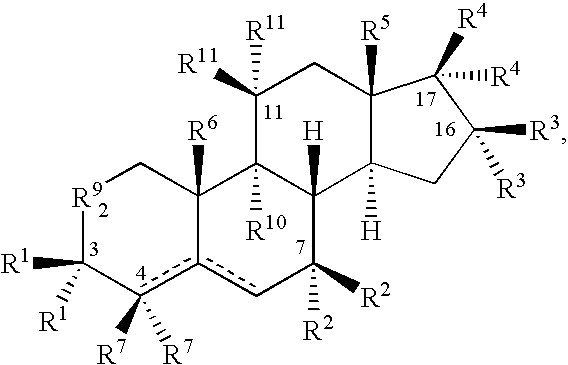Drug Identification and Treatment Method
a technology applied in the field of drug identification and treatment method, can solve the problems of significant immune suppression and bone loss, unrecognized etiology of such disorders, and elevated levels of natural gr agonists and pharmacological levels of synthetic gr agonists
- Summary
- Abstract
- Description
- Claims
- Application Information
AI Technical Summary
Problems solved by technology
Method used
Image
Examples
example 1
[0144]Treatment of lung inflammation. Three compounds, 3β,16α-dihydroxy-17-oxoandrostane, 3α,16β,17β-trihydroxyandrostane and 3α,16α,17α-trihydroxyandrostane were used to treat inflammation in mice essentially as described (D. Auci et al., Ann. New York Acad. Sci. 1051:730-742 2005). Five to 8 week old CD1 male mice (Charles River, Calco, Italy) were used for the study. The animals were housed in a controlled environment and provided with standard rodent chow and water. Animal care was in compliance with applicable regulations on protection of animals. Mice were allocated into one of the following groups: (1) mice treated with 2% carrageenan-λ in saline (carrageenan-λ treated control group), (2) mice treated with 0.1 mg, 0.01 mg or 0.001 mg 3β,16α-dihydroxy-17-oxoandrostane by subcutaneous (s.c.) injection 24 h and 1 h before carrageenan-λ administration, (3) mice treated with 0.1 mg, 0.01 mg or 0.001 mg of 3α,16α,17α-trihydroxyandrostane by s.c. injection 24 and 1 h before carragee...
example 2
[0150]Analysis of the immune response. The compound 3α,16α,17α-trihydroxyandrostane was found to have biological properties that make the compound superior as an agent to treat an inflammation condition such as asthma. Specifically, the use of the compound was not accompanied by a rebound in IL-13, which is a known side effect of antiinflammatory glucocorticoid compounds such as dexamethasone. The IL-13 rebound after glucocorticoid makes an asthma patient more prone to have subsequent acute flare, so an antiinflammatory agent that does not do this would be advantageous. This lack of an IL-13 rebound was unexpected.
[0151]The capacity of 3α,16α,17α-trihydroxyandrostane to limit eosinophil burden and to reduce key inflammatory mediators (IL-5, IL-13, cysteinyl leukotrienes) was observed in the ovalbumin (OVA) sensitized mouse model of asthma. BALB / c mice were sensitized by intraperitoneal injection with OVA (in alum adjuvant) on days 1, and 12. Airways were challenged with OVA on days ...
example 3
[0156]Treatment of lethal inflammation / shock. Two compounds, 16α-bromoepiandrosterone (3β-hydroxy-16α-bromoandrostane-17-one) and 3β,16α-dihydroxy-17-oxoandrostane, were used in a lethal shock protocol. In one protocol, 3 mg of 16α-bromoepiandrosterone was administered to one group of animals by oral gavage, while another group received 3 mg of 16α-bromoepiandrosterone by subcutaneous injection. A group of control animals received a placebo control. In this protocol, the 16α-bromoepiandrosterone was administered to mice at 24 hours before and at 1 hour after administration of a lethal amount of bacterial lipopolysaccharide (LPS). By the end of the observation period, 72 hours after LPS administration, none of the vehicle treated placebo control animals had survived, while 65% of animals that received 16α-bromoepiandrosterone by oral administration survived. 50% of the animals that received 16α-bromoepiandrosterone by subcutaneous injection survived. Animals that survived for 72 hour...
PUM
 Login to View More
Login to View More Abstract
Description
Claims
Application Information
 Login to View More
Login to View More - R&D
- Intellectual Property
- Life Sciences
- Materials
- Tech Scout
- Unparalleled Data Quality
- Higher Quality Content
- 60% Fewer Hallucinations
Browse by: Latest US Patents, China's latest patents, Technical Efficacy Thesaurus, Application Domain, Technology Topic, Popular Technical Reports.
© 2025 PatSnap. All rights reserved.Legal|Privacy policy|Modern Slavery Act Transparency Statement|Sitemap|About US| Contact US: help@patsnap.com



